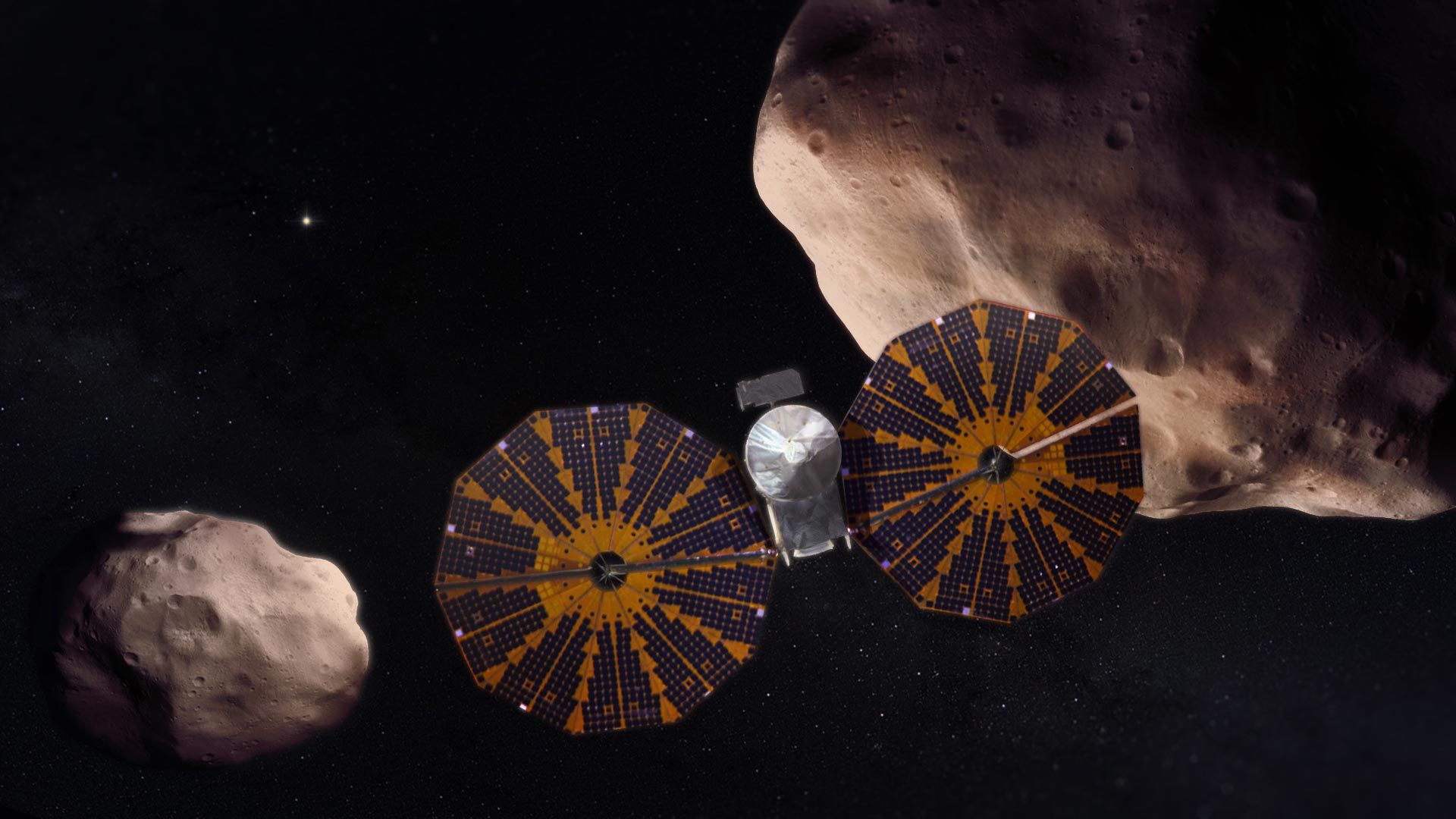Lucy explorará los asteroides troyanos de Júpiter, que se cree que son «fósiles de formación de planetas». Crédito: Centro de Vuelo Espacial Goddard de la NASA
Incluso antes de su lanzar en octubre de 2021,[{» attribute=»»>NASA’s Lucy mission was already on course to break records by visiting more asteroids than any previous mission. Now, the mission can add one more asteroid to the list, after a surprise result from a long-running observation campaign.
Lucy’s science team discovered on March 27 that the smallest of the mission’s Trojan asteroid targets, Polymele, has a satellite of its own. On that day, Polymele was expected to pass in front of a star. This would allow the team to observe the star blink out as the asteroid briefly blocked, or occulted, it. The Lucy team planned to measure the location, size, and shape of Polymele with unprecedented precision while it was outlined by the star behind it. To do so, they spread 26 teams of professional and amateur astronomers across the path where the occultation would be visible.

A graphic showing the observed separation of asteroid Polymele from its discovered satellite. Credit: NASA’s Goddard Space Flight Center
These occultation campaigns have been enormously successful in the past, providing valuable information to the mission on its asteroid targets, but this day would hold a special bonus.
We were thrilled that 14 teams reported observing the star blink out as it passed behind the asteroid. However, as we analyzed the data, we saw that two of the observations were not like the others,” said Marc Buie, Lucy occultation science lead at the Southwest Research Institute, which is headquartered in San Antonio. “Those two observers detected an object around 200 km (about 124 miles) away from Polymele. It had to be a satellite.”

A graphic showing the observed separation of asteroid Polymele from its discovered satellite. Credit: NASA’s Goddard Space Flight Center
Using the occultation data, the scientists determined that this satellite is roughly 3 miles (5 km) in diameter, orbiting Polymele, which is itself around 17 miles (27 km) along its widest axis. The observed distance between the two bodies was approximately 125 miles (200 km).
Following planetary naming conventions, the satellite will not be issued an official name until the team can determine its orbit. As the satellite is too close to Polymele to be clearly seen by Earth-based or Earth-orbiting telescopes – without the help of a fortuitously positioned star – that determination will have to wait until Lucy approaches the asteroid in 2027, unless the team gets lucky with future occultation attempts before then.
At the time of the observation, Polymele was 480 million miles (770 million km) from Earth. Those distances are roughly equivalent to finding a quarter on a sidewalk in Los Angeles – while trying to spot it from a skyscraper thousands of miles away in Manhattan.

Using the occultation data, the team assessed that this satellite is roughly 3 miles (5 km) in diameter, orbiting Polymele, which is itself around 17 miles (27 km) along its widest axis. The observed distance between the two bodies was about 125 miles (200 km). Credit: NASA’s Goddard Space Flight Center
Asteroids hold vital clues to deciphering the history of the solar system – perhaps even the origins of life. Solving these mysteries is a high priority for NASA. The Lucy team originally planned to visit one main belt asteroid and six Trojan asteroids, a previously unexplored population of asteroids that lead and follow Jupiter in its orbit around the Sun. In January of 2021, the team used the Hubble Space Telescope to discover that one of the Trojan asteroids, Eurybates, has a small satellite. Now with this new satellite, Lucy is on track to visit nine asteroids on this remarkable 12-year voyage.
“Lucy’s tagline started out: 12 years, seven asteroids, one spacecraft,” said Lucy program scientist Tom Statler at NASA Headquarters in Washington. “We keep having to change the tagline for this mission, but that’s a good problem to have.”
El 9 de enero de 2020, Mission Lucy anunció oficialmente que no visitaría siete, sino ocho asteroides. Aparentemente, Eurybates, uno de los asteroides a lo largo del camino de Lucy, tiene un pequeño satélite. Poco después de que el equipo de Lucy descubriera el satélite, tanto él como Euribate se colocaron detrás del Sol, lo que impidió que el equipo siguiera observando. Sin embargo, los asteroides surgieron detrás del Sol en julio de 2020 y desde entonces el equipo de Lucy ha podido observar el satélite con el Hubble en múltiples ocasiones, lo que le permitió al equipo definir con precisión la órbita del satélite y permitir que el pequeño satelital finalmente obtuviera una imagen. nombre oficial – Queta.
El investigador principal de Lucy tiene su sede en Boulder, Colorado, una sucursal del Southwest Research Institute, con sede en San Antonio, Texas. El Centro de Vuelo Espacial Goddard de la NASA en Greenbelt, Maryland, proporciona gestión general de la misión, ingeniería de sistemas y seguridad y garantía de la misión. Lockheed Martin Space en Littleton, Colorado construyó la nave espacial. Lucy es la decimotercera misión del Programa Discovery de la NASA. El Centro de Vuelo Espacial Marshall de la NASA en Huntsville, Alabama, administra el Programa Discovery para la Dirección de Misiones Científicas de la agencia en Washington.

«Maven de internet exasperantemente humilde. Comunicadora. Fanático dedicado al tocino.»
También te puede interesar
-
Hubble celebra 34 aniversario con espectacular vista de la pequeña Nebulosa Dumbbell
-
Cómo las experiencias sensoriales dan forma a las neuronas
-
Hombre de Mississippi encuentra restos fósiles de tigre dientes de sable que datan de hace 10.000 años
-
SpaceX lanza 23 satélites Starlink y aterriza el cohete número 300 (foto)
-
SpaceX completa el aterrizaje del propulsor Falcon número 300 durante la misión Starlink – Spaceflight Now

